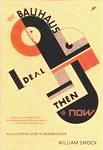“Form follows function.” “Less is more.” Sound familiar? We’ve all heard these design dictums, but what was their original context? Do they still matter today? Last week, I wandered into Strand’s ample new second-story space and picked up a copy of The Bauhaus Ideal: Then and Now, in which designer and filmmaker William Smock presents a jaunty overview of Modernist design and its legacy.
 The book is subtitled “An Illustrated Guide to Modernist Design,” but the author doesn’t use “Bauhaus” and “Modernism” interchangeably. He just wants you to know that the former epitomizes the latter: “Most modern design ideas predate the Bauhaus… but the Bauhaus wrapped them up in a compelling package.” Smock examines this package — what he calls “the Bauhaus ideal” — throughout the book. He focuses on the work of architects and industrial designers, “whose output is all around us and built to last.” Smock wants to see if there are any lessons to be learned from “fifty years of Modernist experimentation.” Contemplating the current lack of confidence in the modernist ideal of infinite progress, he asks: “What is the designer’s mandate now?”
The book is subtitled “An Illustrated Guide to Modernist Design,” but the author doesn’t use “Bauhaus” and “Modernism” interchangeably. He just wants you to know that the former epitomizes the latter: “Most modern design ideas predate the Bauhaus… but the Bauhaus wrapped them up in a compelling package.” Smock examines this package — what he calls “the Bauhaus ideal” — throughout the book. He focuses on the work of architects and industrial designers, “whose output is all around us and built to last.” Smock wants to see if there are any lessons to be learned from “fifty years of Modernist experimentation.” Contemplating the current lack of confidence in the modernist ideal of infinite progress, he asks: “What is the designer’s mandate now?”
Smock introduces the principles (and principals) of Modernist design in the book’s first section, which is intended for people under 45. He also relates Modernism’s ties to modern art, and contrasts the International Style with the design trends that preceded and succeeded it. The Postmodern reaction that began in the late 1970s, when Modernism stopped “looking new,” is of particular interest to Smock.
In the second section, he goes on to critically examine Modernist artifacts, corroborating their achievements and shortcomings. Here the author takes a hard look at concepts such as the language of vision, functionalism, and social engineering, “trying to see where Modernism went astray.” In weeding out Modernist “false promises,” his objective is twofold: to arrive at a core of truth, and to clear the way for new ideas.
If Postmodernism is the antithesis to Modernism’s thesis, Smock wonders: “Can postmodern irony and modernist conviction be brought into a complementary relation?” In the final part of the book, he proposes “a marriage between the best postmodern characteristics — irony, critical self-awareness, modesty — and the best modernist ones — honesty, generosity, and reasonableness.” In this regard, he offers some ideas and amusing observations about reaching that “happy medium.”
With its many pencil illustrations and large type, at first glance The Bauhaus Ideal: Then and Now may remind you of a childhood storybook (a possibility that was not lost on the writer(s) of the jacket blurb). Sure, this isn’t an erudite, difficult tome, but then again Smock believes that “design is for everybody.” Hence, this is a very readable layman’s guide — one surely meant for designers, as well, to judge from its closing section (something a good friend astutely pointed out to me). And while the modest Smock claims to be neither expert nor scholar, he doesn’t shy away from making provocative or critical remarks — even the bibliography has opinionated annotations! Happily, in this charming and lively book, those opinions are balanced by wry insights into design problems and the type of thinking needed to solve them.
![]()
Ricardo Cordoba is a graphic designer. He lives in Brooklyn and is currently working on a geometric, modular typeface, in the belief that there aren’t enough of those to go around.
![]()
The Bauhaus Ideal: Then and Now by William Smock
146 pages, Hardcover
Publisher: Academy Chicago Publishers
ISBN: 0897335228






shortly after leaving college I did a mentorship with a graduate of the "New" Bauhaus (now the Art Institue of Chicago) -- the name given the school when it came to the US during Nazi rule. He, the sculptor David Aaron, was mentored by Lazlo Moholy-Nagy.
To some extent the Bauhaus, as well as the Constructivists would be considered influencers on my approach.
So I've always had a soft spot for well written books on the Bauhaus and this one is no expection. Thanks Ricardo for posting the review. The importance of past artistic Avant-gardes in current design practices is undeniable.
Smocks question,, "Can postmodern irony and modernist conviction be brought into a complementary relation?” is an interesting one and I think the answer is quite possibly yes.
In 2001 my spouse went to the bauhaus Museum, which Ricardo links to in the review and didn't get me the one thing I wanted that they, then, had at the museum store: wrist watches designed in the Bauhaus tradition (which they sadly no longer sell).
Interestingly enough though, 1 year later, a friend gifted me with an M & Co. watch that was curiously reminiscent of the Bauhas style watch I lusted after -- with a postmodern twist. The M & Co. watch I had contained two numbers: 12 and 5 (the watch this link leads to has 10, 1 and 4). The M & co, watch would be one example of this combination of modernism and post-modernism.
However, it crosses my mind that postmodernism is all about reuse of the past: in the strictest theoretical sense any infusion of past isms into postmoderism remains in the post-modernist realm -- unless one is to create a theoretical framework for an entirely new ism.
On Feb.20.2005 at 09:40 PM